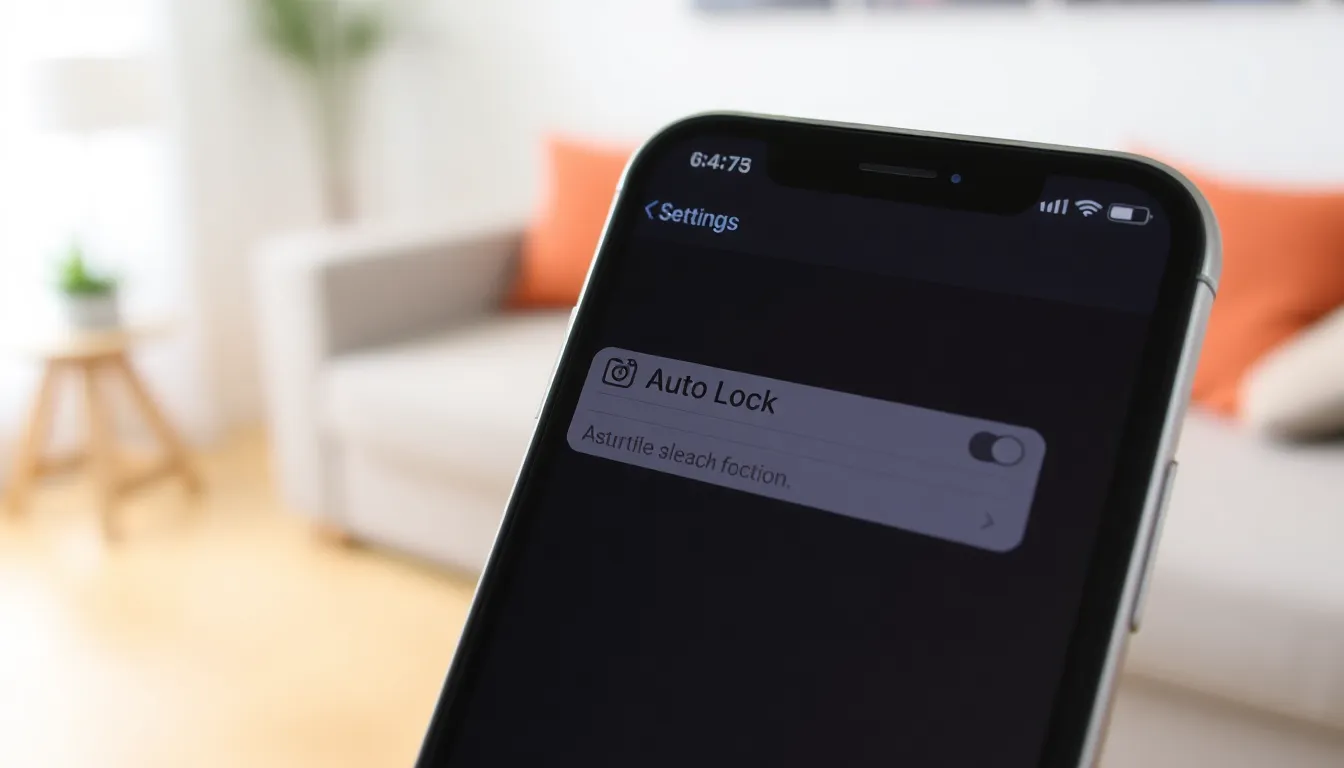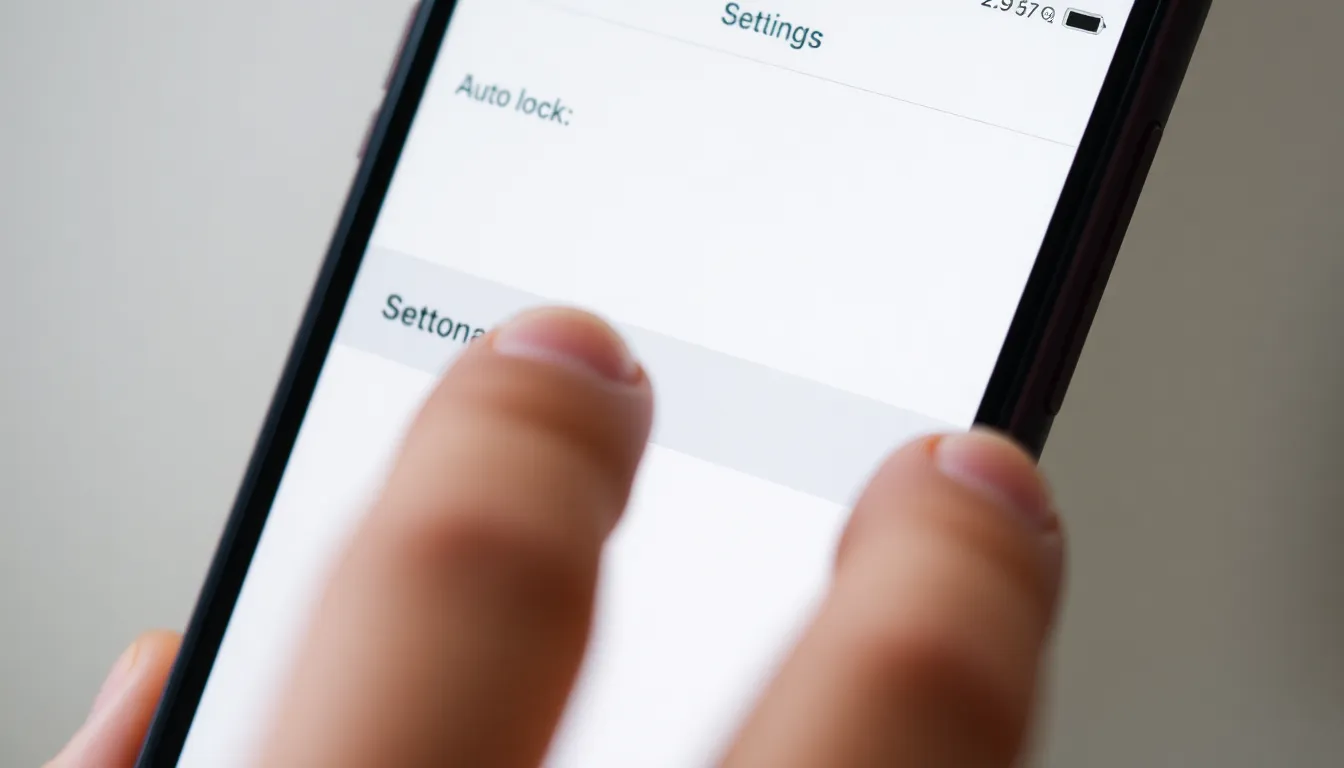Table of Contents
ToggleEver found yourself staring at your iPhone, wondering why the auto lock feature seems to have taken a permanent vacation? You’re not alone. Many users experience the frustration of a grayed-out auto lock option, leaving them pondering the mysteries of their device like a detective in a tech noir film.
Understanding Auto Lock on iPhone
Auto lock on an iPhone controls when the device’s screen turns off automatically. Users often rely on this feature to save battery life and maintain privacy.
What Is Auto Lock?
Auto lock enables an iPhone to automatically lock the device after a set period of inactivity. Users can adjust settings from the Display & Brightness section in the Settings app. Common options include 30 seconds, 1 minute, 2 minutes, 3 minutes, and 5 minutes. An automatic lock ensures that the screen turns off when not in use, reducing the risk of accidental touches. The feature also secures personal information stored on the device by requiring a passcode or Face ID upon awakening.
Importance of Auto Lock Feature
The auto lock feature serves several important functions. First, it helps extend battery life by turning off the display during inactivity. Securing personal data improves privacy and decreases the likelihood of unauthorized access. In public settings, auto lock acts as a safeguard against potential theft or unwanted interactions. Users benefit from a more peace of mind knowing their device isn’t displaying sensitive information when left unattended.
Common Reasons for Grayed Out Auto Lock

Several factors contribute to the auto lock feature being grayed out on an iPhone. Understanding these issues can lead to effective solutions.
Screen Time Restrictions
Screen Time restrictions can limit the functionality of the auto lock feature. When enabled, this setting controls various aspects of device usage, including content restrictions and time limits. If a user has configured specific time settings, they might inadvertently restrict auto lock options. Checking Screen Time settings can reveal whether any restrictions affect auto lock’s availability. Disabling or adjusting these restrictions often restores auto lock functionality.
Device Settings Misconfigurations
Device settings misconfigurations frequently result in a grayed out auto lock option. Changes in general settings, especially those related to display and brightness, may inadvertently affect auto lock functionality. Users must verify that settings comply with preferences for auto lock duration. Resetting all settings can also resolve persistent issues if misconfigurations occur. Ensuring that settings align reduces the likelihood of encountering the grayed out auto lock problem.
Troubleshooting Steps
To address the issue of the grayed out auto lock feature, follow the steps below. These methods can help restore functionality quickly.
Restarting Your iPhone
Restarting the iPhone solves many minor glitches. Begin by pressing and holding the Side button and either Volume button until the slider appears. Move the slider to turn off the device. After it powers down completely, wait a moment before pressing the Side button to turn it back on. This simple action often resolves issues, including problems with the auto lock settings.
Checking for Software Updates
Software updates can introduce improvements and fix existing bugs. Navigate to Settings, tap General, and select Software Update. If an update is available, download and install it. Up-to-date software ensures that all features, including auto lock, operate as intended, minimizing frustration associated with grayed out options.
Resetting Settings
Resetting settings restores defaults without erasing data. Go to Settings, tap General, and select Transfer or Reset iPhone. Then, choose Reset All Settings. This action helps eliminate any potentially problematic configurations causing the auto lock feature to be grayed out. After performing this reset, users should revisit auto lock settings to confirm their functionality.
Advanced Solutions
Exploring advanced solutions can further assist users facing the auto lock grayed out issue on iPhones. Consider the following options after addressing simpler troubleshooting methods.
Factory Reset
Performing a factory reset serves as a comprehensive approach to resolve persistent device problems. Before initiating this process, backing up important data is essential since it erases all content and settings. To execute a factory reset, users navigate to Settings, select General, and tap Transfer or Reset iPhone. Choosing Erase All Content and Settings initiates the reset. After the device restarts, users can set it up as new or restore from backup. Many find that this process restores all functionalities, including the auto lock feature.
Contacting Apple Support
Reaching out to Apple Support can provide specialized assistance for users unable to resolve the grayed-out auto lock issue. Apple’s representatives can guide users through diagnostic steps tailored to specific situations. Users can contact support via the Apple Support app, website, or by visiting an Apple Store. When contacting support, preparing the device information, such as model and iOS version, ensures efficient troubleshooting. Many users benefit from expert advice that addresses underlying issues related to software or hardware that simpler methods may overlook.
Resolving the issue of a grayed out auto lock feature on an iPhone can significantly enhance user experience. By understanding the potential causes such as Screen Time restrictions and device misconfigurations users can take informed steps to regain control over their settings. Simple troubleshooting methods like restarting the device or checking for software updates often prove effective.
For persistent problems advanced solutions like a factory reset or contacting Apple Support may be necessary. With the right approach users can restore the auto lock feature and enjoy the benefits of improved battery life and enhanced security. Taking these steps ensures that the iPhone remains a reliable tool for daily use.



